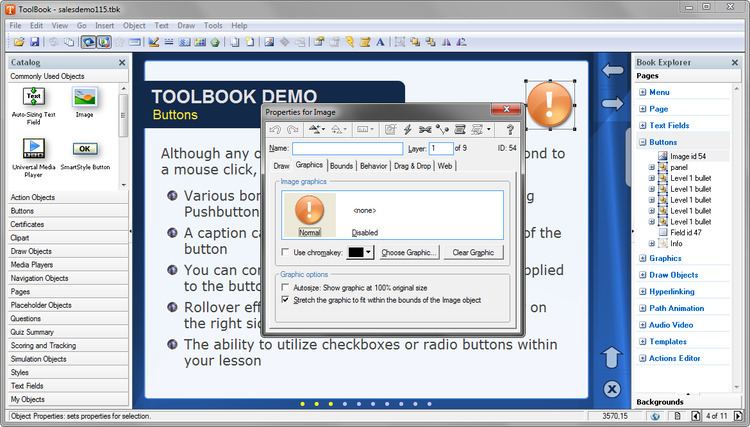ToolBook is a SCORM and AICC compliant Microsoft Windows based e-learning content authoring application initially released in 1990 by Asymetrix Corporation, which later became click2learn and then SumTotal Systems. Asymetrix was founded by Paul Allen, one of the original partners in Microsoft.
For the first several releases ToolBook was seen as a competitor to Visual Basic as a Windows programming environment, to be used to create Windows applications. ToolBook 3 introduced the added ability to create training lessons, offering a variety of question types and scoring behaviors. With the release of version 5, ToolBook introduced the ability to publish a lesson into HTML format. Since that time ToolBook has been continually enhanced to allow for the HTML to be viewed on a wide variety of web browsers and mobile devices.
ToolBook uses a book metaphor (a project file is thought of as a book containing pages of content). This is very similar to PowerPoint's use of the metaphor where presentations contain various slides. ToolBook allows for the creation of Windows-based applications/training [termed 'Native content'], as well as web-based applications/training [termed 'DHTML content'].
To support these two distribution models, ToolBook contains two different programming environments.
OpenScript: ToolBook includes a very capable built-in programming language called OpenScript, which is similar to HyperTalk. OpenScript is object oriented and event-driven, where chunks of programming code are associated to the different elements within the lesson. The OpenScript language only functions within the Native engine of ToolBook. It does not function in DHTML delivered content.Actions Editor: The Actions Editor is another programming environment where the syntax is virtually identical to OpenScript. The biggest difference is that the Actions Editor is not as powerful a language as OpenScript. Whereas OpenScript has over a thousand commands and functions, the Actions Editor contains perhaps 80. However, Actions Editor programming code works equally well within ToolBook (Native) as well as in a web browser (DHTML).ToolBook contains many features, but the key features can be summarized as:
Catalog - The Catalog is a repository of objects that can be added to your project. For example: Text fields, Buttons, Question Objects, Rectangles, Navigation Controls. You can even add your own objects to the catalog so that they can be used later in different projects.Book Explorer - The Book Explorer will display a tree-view breakdown of all objects on a given page.PowerPoint Converter - The PowerPoint Add-on (called SumTotal Publish To ToolBook) will allow you to convert a PowerPoint presentation into a ToolBook file. Once installed, you'll find this Add-on within the main Ribbon within PowerPoint.Simulation Recorder - The Simulation Recorder will watch and record you interacting with another application, and allow you to import that simulation into ToolBook as an interactive simulation (this is not a video recording).Simulation Editor - You can create your own simulations manually or edit/modify a simulation you recorded using the Simulation Recorder. Simulations can be played back in 3 modes: Demonstration (sit back and watch), Practice (provides detailed next-step instruction to user, allowing them to complete the simulation), Assessment (let the user attempt the simulation by themselves).Path Animation - Any object in ToolBook can be configured to move (animate) across the page using a simple or even complex path.Media Players - ToolBook supports the ability to play Audio and Videos in a wide variety of formats, supported by these 4 media technologies: Windows Media Player, RealPlayer, QuickTime, Flash.Publish To Web - The ability to view a lesson in DHTML format for use in a Web Browser is accomplish by using the Publish To Web feature.SCORM/AICC - ToolBook provides SCORM and AICC support within web-published lessons for use in SCORM/AICC compliant Learning Management Systems.AutoPackager - In order to distribute a Native lesson or application to a Windows computer (in non-DHTML format), the AutoPackager is used. It has the ability to wrap your lesson into a Windows Installer so an end user can install it onto their computer.Quiz - Many question objects (True/False, Multiple-Choice, Match Item, etc.) exist in ToolBook to allow you to create a training lesson. Various scoring behaviors also exist, such as Score This Page (or Range of Pages). Using the Actions Editor, you can design complex navigation within a lesson based on individual question scores.OpenScript - Powerful built-in programming language suitable for creating Native ToolBook lessons and applications.Actions Editor - Built-in programming language designed for creating lessons and applications which will be distributed in Native format or DHTML format.
